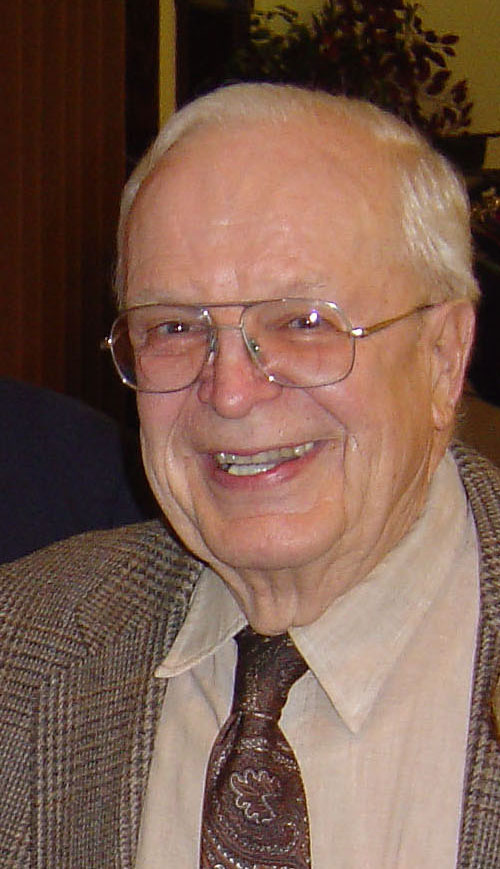In memoriam: C.W. Smith, Alumni Distinguished Professor Emeritus of Engineering Science and Mechanics

The Virginia Tech College of Engineering is remembering Professor C. W. "Bill" Smith, Alumni Distinguished Professor Emeritus of Engineering Science and Mechanics and a member of the Academy of Engineering Excellence at Virginia Tech. The lifetime resident of Christiansburg, Va., died July 30.
A celebration of his life will be held at St. Paul’s United Methodist Church at 10 a.m. Saturday, Aug. 4, followed by a brief graveside ceremony in Sunset Cemetery in Christiansburg. The family will be available at the church to greet visitors prior to the service.
Smith was the epitome of the hometown boy who made good. Born in Christiansburg, he lived in the same home his grandfather built in 1905 and where he was raised. The October 1929 stock market crash forced the sale of the home, but Smith was able to purchase the landmark building back in 1948. He continued to live there until recently when his health failed.
While attending Virginia Tech, Smith garnered some experience his senior year teaching mathematics, and that landed him a job offer from Dan Pletta, the engineering mechanics department head during the 1940s. Smith pursued his master’s degree and became a full time instructor in 1948. When Smith earned his graduate degree in 1950, Pletta promoted him to an assistant professor, and Smith taught five classes at a salary of some $200 a month.
“Sponsored research was unheard of at the time,” Smith said in a 2006 interview, but George Irwin changed Smith’s view of an academic’s life. When Irwin, a member of the Lehigh University faculty and considered to be the “father of fracture mechanics,” visited Virginia Tech to deliver a seminar, Smith candidly recalled his own response. “I found his talk intriguing but I had no idea what he was talking about. That got me interested, and I went to some short courses at MIT and at the University of Denver (Colorado) Research Institute” to learn more.
Subsequently, Smith became one of the first engineering faculty members to transition from a strictly teaching role to assuming a teaching and research responsibility in the college. Smith was one of Virginia Tech’s investigators on the 1969 Themis grant, the landmark U.S. Department of Defense program that catapulted the university into its current international stature in composite and advanced materials.
In 1977, the university recognized Smith for his many achievements, presenting him with its Alumni Award for Excellence in Research. That same year, the Society for Experimental Mechanics made Smith a Fellow. In 1986, he received NASA’s Langley Research Center Scientific Achievement Award. Other honors followed including election to Fellow of the American Academy of Mechanics in 1991 and of the American Society of Mechanical Engineers in 1996. He became an honorary member of the Society for Experimental Mechanics in 2002.
In Smith’s field of research, fracture mechanics, his work is known “worldwide” as are his contributions to the discipline of photoelasticity. In recognition of his accomplishments, Smith has received numerous honors including the 1983 M.M. Frocht Award, the 1993 William M. Murray Medal, and the 1995 B.J. Lazan Award, all from the Society of Experimental Mechanics.
Smith balanced his act of teaching and research well. In 1991, he received the statewide Dan Pletta Engineering Educator of the Year Award from the Virginia Schools of Engineering. Each year until his retirement, he served as an unofficial advisor to the 15 or 20 Department of Engineering Science and Mechanics seniors. He and his wife, Doris, also deceased, would also act as chaperones at the College of Engineering dances.
In 1992, Smith retired but retained his status as an Alumni Distinguished Professor Emeritus. He continued to come to the office, and retained his research laboratory for another 10 years or so. When his lab closed, he spent his office time as the head of the department’s honorifics committee.
Smith directed some 50 graduate-level students, helped establish a foreign-exchange program with Lomonosov Moscow State University, authored or co-authored more than 150 technical papers, wrote five book chapters, served as an editor for such publications as Fracture Mechanics and the Journal of Theoretical and Applied Fracture Mechanics, and received notable listings in American Men in Science, Who’s Who in Engineering, and Who’s Who in Frontiers of Science and Technology.
He was known fondly as the Department of Engineering Science and Mechanic’s “chaplain.” There also was a time when, as the oldest person in the department, he was recruited to form a committee to help solve technical disagreements between faculty members.



.jpg.transform/m-medium/image.jpg)
